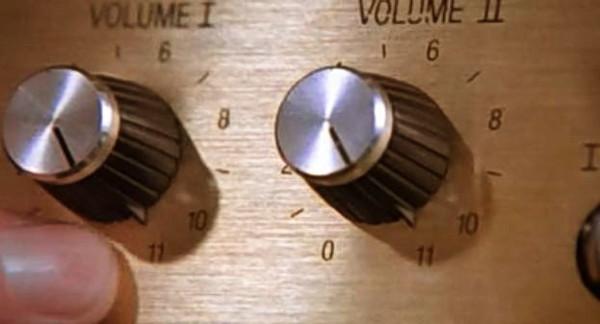Beware the Spinal Tap Syndrome

The scene is renowned and has entered the popular culture as a way to point out needless excess, and particularly excess that demonstrates confusion, or otherwise serves no purpose. It’s my opinion that some audio technology now has knobs that go to 11.
I am most certainly not a Luddite. I live and breathe for engineering innovation. Better, stronger, faster—I’m all for it. If Porsche wants to build a 918 Spyder with 887 horsepower (0 to 60 in 2.5 seconds and combined fuel consumption of 67 MPGe), I’m for it. I’ll never drive a 918, but Porsche’s hybrid-motor technology might trickle down to a car I might own. The 918 embodies quantifiable improvements in technology. But occasionally, we see “improvements.” Enter the new generation of audio players that are spec’d at 32-bit quantization, and 384-kHz sampling frequency.
Thirty-two-bit quantization gives a theoretical signal-to-error ratio of about 192 decibels. That is an impressive number, all the more impressive when you consider that a very quiet studio might have a noise floor rated at NCB-10, and the threshold of audibility of the human ear is NCB-0. Put in perspective, that’s the noise floor generated as air molecules randomly and gently touch our eardrums. Playback over a dynamic range of 100 dB is remarkable; quantizing 32 bits makes no sense because it’s physically impossible to actually achieve a 200-dB dynamic range.
A sampling frequency of 384 kHz puts the Nyquist frequency at 192 kHz. That is a remarkable bandwidth that far exceeds the commonly accepted frequency range of human hearing that, on a good day, may extend to 22 or 24 kHz. It is not clear to me how the extra 168 kHz of bandwidth is useful. Indeed, allowing those higher frequencies to enter the recording chain could surely only cause more harm than good in the range of audibility. It’s like a TV manufacturer offering a TV that emitted spectrum content that was far outside that of visible light. Would you buy a TV that emitted UV wavelengths? A tad inconvenient to have to always put on sunblock before watching TV.
One might logically ask, if companies want to develop and market equipment with extraordinarily high specifications, and some people want to buy it, who cares? I mean, what’s the harm? I’ll answer that question with a story. A woman is walking down a street one evening and sees a man searching the ground under a streetlight. He explains, “I lost my car keys.” She starts helping him look. After a while, no keys in sight, she exasperatedly asks, “Exactly where did you lose them?” “Oh,” the man says, “a little ways up the street.” “Then why are you looking for them here?” He answers, “Because the light is better here.”
That’s one problem (of several) I have with 384-kHz/32-bit audio. It’s possible to build that kind of player, but it robs resources from very real problems that are just up the street. An engineer’s time would be better spent in finding solutions to serious audio problems. For starters, how about a way to lower the several percent of distortion that is common in most loudspeakers. That would be a solution to a problem, not a solution looking for a problem.
I’ll get off my soapbox now. Time to relax with some music. Maybe Spinal Tap’s new album, Smell the Glove. It sounds awesome—their amps go to 11, you know.
























































